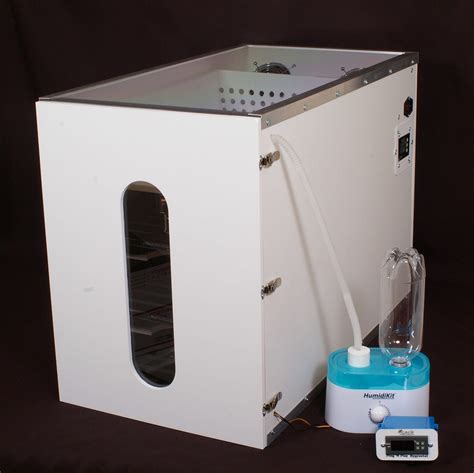How To Control Humidity In A Incubator
Ronan Farrow
Mar 31, 2025 · 3 min read

Table of Contents
How to Control Humidity in an Incubator: A Comprehensive Guide
Maintaining the right humidity level in your incubator is crucial for successful hatching and the overall health of your developing organisms. Whether you're incubating eggs, cultivating cells, or growing delicate plants, precise humidity control is paramount. This guide will walk you through various methods and techniques to effectively manage humidity within your incubator.
Understanding Humidity's Role in Incubation
Humidity, simply put, is the amount of water vapor present in the air. In an incubator, it plays a vital role in:
- Preventing Egg Dehydration: For egg incubation, appropriate humidity levels prevent eggs from drying out, ensuring proper embryonic development. Dehydration can lead to developmental abnormalities and hatching failure.
- Maintaining Cell Viability: In cell culture incubators, humidity maintains the osmotic balance within the cells, preventing them from drying out and dying.
- Supporting Plant Growth: For plant propagation, optimal humidity prevents wilting and promotes healthy growth, especially during the early stages of development.
Methods for Controlling Humidity in an Incubator
There are several ways to control humidity within an incubator, ranging from simple adjustments to more sophisticated techniques:
1. Using a Water Pan or Tray: The Passive Approach
This is the most common and often the simplest method. Simply placing a tray of water inside the incubator will increase the humidity level through evaporation. The size of the tray and the amount of water will directly influence the humidity level.
- Pros: Inexpensive, readily available, easy to implement.
- Cons: Difficult to precisely control humidity; evaporation rate is affected by temperature and air circulation; requires regular monitoring and refilling.
2. Utilizing a Hygrometer: Monitoring is Key
A hygrometer is a crucial tool for monitoring humidity levels. It accurately measures the relative humidity (RH) inside the incubator. By regularly checking the readings, you can adjust your humidity control methods accordingly.
- Analog vs. Digital: Both analog and digital hygrometers are available. Digital hygrometers usually offer greater accuracy and ease of reading.
3. Employing a Humidity Controller: Precise Regulation
For more precise control, a humidity controller is indispensable. These devices automatically regulate the humidity level by activating a humidifier or dehumidifier as needed. They maintain a stable environment, reducing the risk of fluctuations.
- Features: Look for controllers with programmable set points, alarms, and clear displays.
4. Adjusting Ventilation: A Subtle but Important Factor
The rate of ventilation influences humidity levels. Increased ventilation will lead to lower humidity, and vice-versa. Adjusting the ventilation settings can be a helpful fine-tuning method, especially in conjunction with other techniques. However, be mindful that proper ventilation is crucial for preventing the buildup of harmful gases.
Troubleshooting Common Humidity Issues
- Humidity Too Low: Increase the size of the water tray, add more water, reduce ventilation, or utilize a humidifier.
- Humidity Too High: Decrease the amount of water in the tray, increase ventilation, or use a dehumidifier (if available).
- Inconsistent Humidity: Ensure proper air circulation within the incubator, regularly check and refill the water tray, and consider using a humidity controller for better stability.
Choosing the Right Method for Your Needs
The best method for controlling humidity will depend on your specific needs and the type of incubator you are using. For simple applications with less stringent humidity requirements, a water tray may suffice. For applications requiring precise humidity control, a humidity controller is strongly recommended. Remember to always prioritize accurate monitoring using a hygrometer.
By understanding the role of humidity and implementing the appropriate control methods, you can significantly increase the chances of successful incubation and optimal growth within your incubator. Remember that consistency is key; regular monitoring and adjustment will lead to the best results.
Featured Posts
Also read the following articles
| Article Title | Date |
|---|---|
| How To Get To Chebeague Island | Mar 31, 2025 |
| How To Get A Apartment With No Job | Mar 31, 2025 |
| How To Distress Paper | Mar 31, 2025 |
| How To Get Rid Of Ants Around Pool | Mar 31, 2025 |
| How To Get Nurse Practitioner License In Another State | Mar 31, 2025 |
Latest Posts
-
How Hard Is It To Get Into Ibew
Apr 04, 2025
-
How Hard Is It To Get Into Davidson Young Scholars
Apr 04, 2025
-
How Hard Is It To Get Into Chiropractic School
Apr 04, 2025
-
How Hard Is It To Catch A Bluefin Tuna
Apr 04, 2025
-
How Hard Is Dental Assisting
Apr 04, 2025
Thank you for visiting our website which covers about How To Control Humidity In A Incubator . We hope the information provided has been useful to you. Feel free to contact us if you have any questions or need further assistance. See you next time and don't miss to bookmark.
